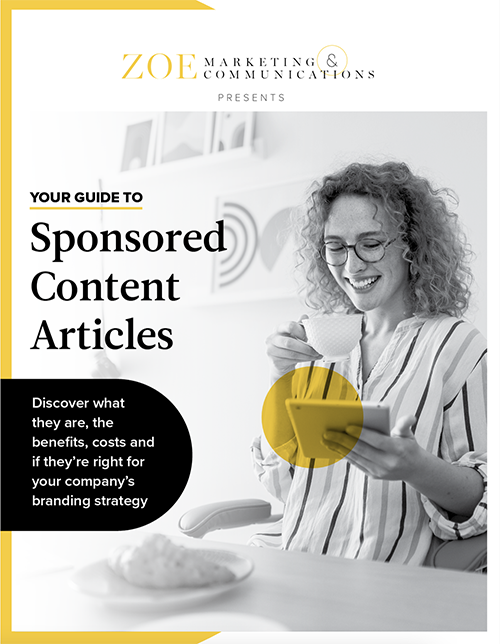Choosing content marketing or digital ads is like picking “tell” or “show.”
Articles tell your story and build trust. Ads show your message quickly and drive clicks.
Which is right for you? That’s an FAQ here at Zoe Marketing & Communications. We help clients navigate both, choosing the approach (or combination) that delivers results.
To decide, let’s break down the differences across six key areas.
Free Guide
Download the Sponsored Content Guide
Discover what “spon con” is, the benefits, costs and if it’s right for your company’s digital marketing strategy.
5 key differences between content marketing and digital ads
1. What they look and feel like
✍️ Content marketing: Written articles
Each typically has a headline, subheadline, lead image, byline and body copy (around 400-700 words). They appear as:
- Blogs on your website, written by your experts
- Sponsored content on an aligned media partner’s site
They’re educational, not salesy — designed to engage and build credibility.
A good blog answers questions people are already asking, making your brand a trusted resource.
🖼️ Digital ads: Designed boxes
These “click me!” squares and rectangles are small but powerful visuals that show up on websites, apps and social media. They feature:
- A strong image
- A short, direct message
- A clear call to action (CTA)
Unlike content, ads are overtly promotional. Their goal is clicks and conversions.
2. Goals they serve
✍️ Content marketing: Branding
- Builds long-term trust and credibility
- Helps with search engine optimization (SEO), increasing visibility in Google search results
- Keeps people engaged longer (minutes vs. seconds)
🖼️ Digital ads: Direct results
- Focuses on immediate action (clicks, sign-ups, purchases)
- Works well for time-sensitive promotions
- Targets specific demographics for maximum efficiency
3. Time, effort and payoff
✍️ Content marketing: A longer process
- Takes time to develop, write, optimize and promote good topics (often 1-3 weeks)
- Interviewing experts (which boost credibility) also takes time
- Can take 3-12 months to gain SEO traction
- Keeps your brand memorable for longer decision cycles
🖼️ Digital ads: Faster results
- Can launch in as little as a day (as long as ads are designed and audience targeting is set)
- Yields insights within a month
- Allows quick adjustments based on performance
4. What they cost
✍️Content marketing: Higher upfront cost
- $500-$1,000+ per professionally written blog (ideally need 4+ per month, bringing costs to $2,000+)
- $500-$2,000+ per sponsored content article
- Best when part of a long-term strategy (1-3 articles per week)
🖼️ Digital ads: Lower entry cost
- $1,000-$9,000/month for web ads (Google, retargeting, programmatic)
- $200-$1,500/month per platform for social media ads
- Success depends on impressions (the more people see your ad, the better the results)
5. Who they’re best for
✍️Content marketing: Longer-cycle decisions
- Examples can include schools, nonprofits, healthcare, service-based businesses
- Companies looking to build trust and educate their audience
- Strongest when combined with ads for faster visibility
🖼️ Digital ads: Quicker decisions
- Examples can include events, camps, limited-time offers
- Works well for products or impulse-driven decisions
- More powerful when paired with content, email marketing and SEO
Next steps in choosing a marketing plan
The bottom line? Content tells your story and builds trust over time. Ads show your message fast and drive immediate action.
So, what’s your best approach? Could it be both? If you need guidance, talk to us. Zoe Marketing & Communications can build a custom marketing strategy that fits your business.
Still exploring? Dig deeper with these blogs:
Kim Kovelle
As Zoe Marketing & Communications’ content manager, Kim Kovelle brings over 20 years of writing and editing experience in metro Detroit. She has strong roots in community journalism and a knack for making complicated topics make more sense.



